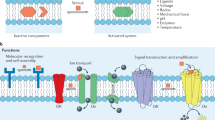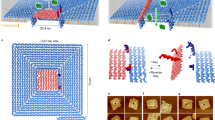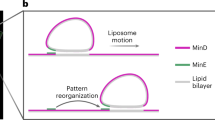Abstract
Transmission and amplification of chemical signals across lipid bilayer membranes is of profound significance in many biological processes, from the development of multicellular organisms to information processing in the nervous system. In biology, membrane-spanning proteins are responsible for the transmission of chemical signals across membranes, and signal transduction is often associated with an amplified signalling cascade. The ability to reproduce such processes in artificial systems has potential applications in sensing, controlled drug delivery and communication between compartments in tissue-like constructs of synthetic vesicles. Here we describe a mechanism for transmitting a chemical signal across a membrane based on the controlled translocation of a synthetic molecular transducer from one side of a lipid bilayer membrane to the other. The controlled molecular motion has been coupled to the activation of a catalyst on the inside of a vesicle, which leads to a signal-amplification process analogous to the biological counterpart.
This is a preview of subscription content, access via your institution
Access options
Subscribe to this journal
Receive 12 print issues and online access
$259.00 per year
only $21.58 per issue
Buy this article
- Purchase on Springer Link
- Instant access to full article PDF
Prices may be subject to local taxes which are calculated during checkout




Similar content being viewed by others
References
Krauss, G. Biochemistry of Signal Transduction and Regulation (Wiley, 2006).
Simon, M. I., Strathmann, M. P. & Gautam, N. Diversity of G proteins in signal transduction. Science 252, 802–808 (1991).
Schlessinger, J. Cell signaling by receptor tyrosine kinases. Cell 103, 211–225 (2000).
Bennett, I. M. et al. Active transport of Ca2+ by an artificial photosynthetic membrane. Nature 420, 398–401 (2002).
Fyles, T. M. Synthetic ion channels in bilayer membranes. Chem. Soc. Rev. 36, 335–347 (2007).
Matile, S., Vargas Jentzsch, A., Montenegro, J. & Fin, A. Recent synthetic transport systems. Chem. Soc. Rev. 40, 2453–2474 (2011).
Gale, P. A. From anion receptors to transporters. Acc. Chem. Res. 44, 216–226 (2011).
Montenegro, J., Ghadiri, M. R. & Granja, J. R. Ion channel models based on self-assembling cyclic peptide nanotubes. Acc. Chem. Res. 46, 2955–2965 (2013).
Stanzl, E. G., Trantow, B. M., Vargas, J. R. & Wender, P. A. Fifteen years of cell-penetrating, guanidinium-rich molecular transporters: basic science, research tools, and clinical applications. Acc. Chem. Res. 46, 2944–2954 (2013).
Watson, M. A. & Cockroft, S. L. Man-made molecular machines: membrane bound. Chem. Soc. Rev. 45, 6118–6129 (2016).
Grimaldi, J. J., Boileau, S. & Lehn, J.-M. Light-driven, carrier-mediated electron transfer across artificial membranes. Nature 265, 229–230 (1977).
Barton, P., Hunter, C. A., Potter, T. J., Webb, S. J. & Williams, N. H. Transmembrane signalling. Angew. Chem. Int. Ed. 41, 3878–3881 (2002).
Dijkstra, H. P. et al. Transmission of binding information across lipid bilayers. Chem. Eur. J. 13, 7215–7222 (2007).
Bernitzki, K. & Schrader, T. Entirely artificial signal transduction with a primary messenger. Angew. Chem. Int. Ed. 48, 8001–8005 (2009).
De Poli, M. et al. Conformational photoswitching of a synthetic peptide foldamer bound within a phospholipid bilayer. Science 352, 575–580 (2016).
Yatsimirsky, A. K., Gómez-Tagle, P., Escalante-Tovar, S. & Ruiz-Ramírez, L. Kinetics and mechanism of ester hydrolysis by metal complexes of 2,6-diacetylpyridine dioxime. Inorg. Chim. Acta 273, 167–174 (1998).
Clement, N. R. & Gould, J. M. Pyranine (8-hydroxy-1,3,6-pyrenetrisulfonate) as a probe of internal aqueous hydrogen ion concentration in phospholipid vesicles. Biochemistry 20, 1534–1538 (1981).
MacDonald, R. C. et al. Small-volume extrusion apparatus for preparation of large, unilamellar vesicles. Biochim. Biophys. Acta 1061, 297–303 (1991).
Wolfbeis, O. S. & Koller, E. Fluorimetric assay of hydrolases at longwave excitation and emission wavelengths with new substrates possessing unique water solubility. Anal. Biochem. 129, 365–370 (1983).
Thompson, N. L. & Pero, J. K. in Fluorescence Spectroscopy in Biology: Advanced Methods and their Applications to Membranes, Proteins, DNA, and Cells (eds Hof, M., Hutterer, R. & Fidler, V.) 79–103 (Springer, 2005).
Blanco, V., Leigh, D. A. & Marcos, V. Artificial switchable catalysts. Chem. Soc. Rev. 44, 5341–5370 (2015).
Acknowledgements
We thank the University of Cambridge Oppenheimer Fund for an Early Career Research Fellowship (M.J.L.), the Wiener-Anspach Foundation for a postdoctoral fellowship (F.K.) and F. Kundel and D. Klenerman for the TIRFM imaging experiments.
Author information
Authors and Affiliations
Contributions
M.J.L., F.K. and M.C. carried out the experimental work. N.H.W. and C.A.H. supervised the project. All the authors contributed to the experimental design, analysis of the results and discussion of the manuscript. M.J.L., F.K., N.H.W. and C.A.H. wrote the paper.
Corresponding authors
Ethics declarations
Competing interests
The authors declare no competing financial interests.
Supplementary information
Supplementary information
Supplementary information (PDF 951 kb)
Rights and permissions
About this article
Cite this article
Langton, M., Keymeulen, F., Ciaccia, M. et al. Controlled membrane translocation provides a mechanism for signal transduction and amplification. Nature Chem 9, 426–430 (2017). https://doi.org/10.1038/nchem.2678
Received:
Accepted:
Published:
Issue Date:
DOI: https://doi.org/10.1038/nchem.2678
This article is cited by
-
Artificial cells for in vivo biomedical applications through red blood cell biomimicry
Nature Communications (2024)
-
Transmembrane signaling by a synthetic receptor in artificial cells
Nature Communications (2023)
-
Programming conformational cooperativity to regulate allosteric protein-oligonucleotide signal transduction
Nature Communications (2023)
-
Engineering receptor-mediated transmembrane signaling in artificial and living cells
Communications Materials (2023)
-
Regulation of artificial supramolecular transmembrane signal transduction by selenium-containing artificial enzyme receptors
Nano Research (2023)



